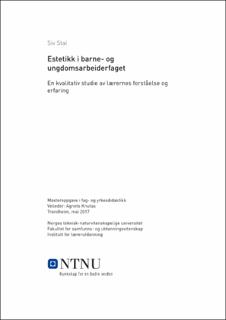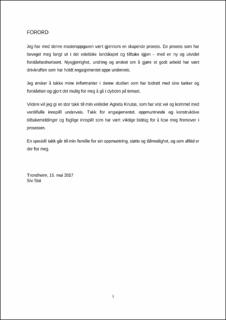| dc.contributor.advisor | Knutas, Agneta | |
| dc.contributor.author | Stai, Siv | |
| dc.date.accessioned | 2020-09-11T08:59:51Z | |
| dc.date.available | 2020-09-11T08:59:51Z | |
| dc.date.issued | 2017 | |
| dc.identifier.uri | https://hdl.handle.net/11250/2677359 | |
| dc.description.abstract | Bakgrunnen for mitt valg av tema er et ønske om større fokus på estetikk i utdanningen av barne- og ungdomsarbeidere, og en bekymring for at den estetiske tilnærmingen i utdanningen er begrenset i forhold til instrumentell tenkning. Barne- og ungsomarbeider er et praktisk yrke og utøveren kan i den forstand sees på som en håndverker. Utdanningen må derfor bidra til at elevene får utvikle sine ferdigheter slik at de får den praktiske kunnskapen som de kan ta i bruk i sitt fremtidige yrke for å kunne gjøre et godt arbeid. Dette er kunnskap som inkluderer hele kroppen – både tanker, følelser og handlinger.
Hensikten med studien er å skape økt bevissthet om bruk av estetikk i utdanningen på barne- og ungdomsarbeiderfaget i videregående skole, samt å skape kunnskap om hva estetikk kan bidra til med utgangspunkt i problemstillingen: På hvilke måter kan estetikk bidra i utdanningen på barne- og ungdomsarbeiderfaget?
Jeg har valgt kvalitativ metode med dybdeintervju av fem lærere for å fremskaffe data i denne undersøkelsen. Videre er data tolket og analysert i relasjon til teorier om utdanning, estetikk og den generelle delen av læreplanen.
I denne studien fremkommer det at estetikk er en prosess der elevene er aktive deltakere i praktiske handlinger. Denne erfaringen gir en dypere forståelse og kunnskap som sitter i kroppen og som derfor medbringes og kan tas i bruk ved senere handlinger. Estetikk i undervisningen bidrar til glede og skaper engasjement hos elevene og kan dermed virke inn på elevenes motivasjon til skole og utdanning. Lærerens rolle i estetiske prosesser blir å delta og dele sine erfaringer og forståelser med elevene, både underveis og etter prosessen. Mot denne bakgrunn blir målstyring og vurdering med karakterer uheldig for den estetiske prosessen.
Oppsummert viser denne studien at estetikk bidrar til at eleven skaper kunnskap, ferdigheter og vurderingsevne som kan tas i bruk i det fremtidige yrket, samtidig som estetikk bidrar til å gi rom for at eleven opplever friheten til å tre frem som et ansvarlig og handlende subjekt i samfunnet. | en_US |
| dc.description.abstract | Abstract:
The background for my choice of subject study is a wish for more emphasis on aesthetics in vocational education of child- and youth workers, and a concern that the aesthetic approach in the education is too restricted in terms of instrumental reasoning. Child- and youth work is a practical profession and can in that respect be viewed as a craft. The education must accordingly facilitate the development of the student's skills so that they can obtain the practical knowledge that is needed for doing a good job in their future profession. These skills include the entire body – thoughts, feelings and physical actions.
The intention of this study is to increase the awareness about the use of aesthetics in the education of child- and youth workers in high school, and to provide knowledge about what contributions aesthetics can offer. The chosen problem statement is, In what ways can aesthetics contribute to the education of child- and youth workers?
In the study I have used a qualitative approach based on data which have been gathered through in-depth interviews of five teachers. The data have been interpreted and analysed in relation to theories about education, aesthetics, and the general part of the high school curriculum plan.
It is shown that aesthetics can be viewed as a process where the students are active participants in practical activities. The obtained experience gives a deeper level of understanding and knowledge that becomes part of the body, and can as such be utilized in later actions. Use of aesthetics gives a feeling of happiness and engagement among the students and can therefore give a positive effect in terms of motivation. The teacher's role in the aesthetic process is to participate and share experiences and understandings with the students, during and after the process. With these considerations, one-sided objective management and evaluation towards grading gives a negative impact on the aesthetic process.
The main finding is that the use of aesthetics contributes to developing knowledge, skills and judgement ability with the students that can later be applied in their future occupation. Aesthetics also gives freedom for the student to step forward as a responsible and active individual in the society. | en_US |
| dc.language.iso | nob | en_US |
| dc.publisher | NTNU | en_US |
| dc.subject | Masteroppgave i fag- og yrkesdidaktikk | en_US |
| dc.title | Estetikk i barne- og ungdomsarbeiderfaget - En kvalitativ studie av lærernes forståelse og erfaring | en_US |
| dc.type | Master thesis | en_US |

